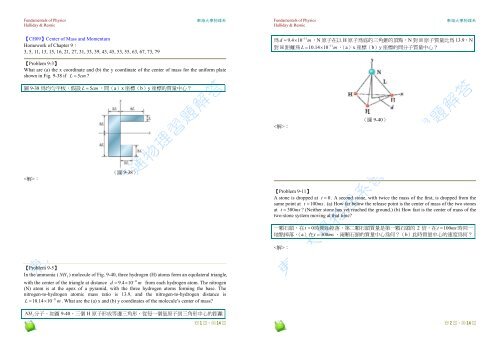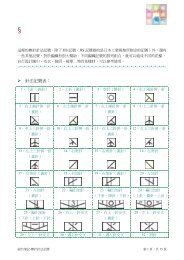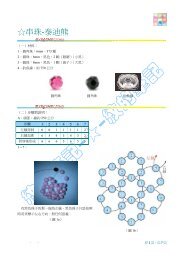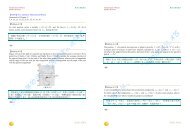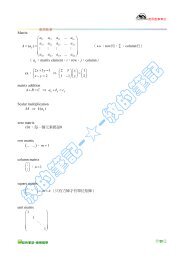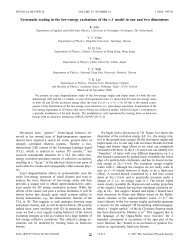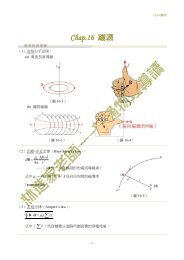【CH09】Center of Mass and Momentum Homework of ... - 物理學系
【CH09】Center of Mass and Momentum Homework of ... - 物理學系
【CH09】Center of Mass and Momentum Homework of ... - 物理學系
You also want an ePaper? Increase the reach of your titles
YUMPU automatically turns print PDFs into web optimized ePapers that Google loves.
Fundamentals <strong>of</strong> Physics<br />
Halliday & Resnic<br />
<strong>【CH09】Center</strong> <strong>of</strong> <strong>Mass</strong> <strong>and</strong> <strong>Momentum</strong><br />
<strong>Homework</strong> <strong>of</strong> Chapter 9:<br />
3, 5, 11, 13, 15, 16, 21, 27, 31, 33, 39, 43, 45, 53, 55, 63, 67, 73, 79<br />
東海大學物理系<br />
【Problem 9-3】<br />
What are (a) the x coordinate <strong>and</strong> (b) the y coordinate <strong>of</strong> the center <strong>of</strong> mass for the uniform plate<br />
shown in Fig. 9-38 if L= 5cm?<br />
圖 9-38 為均勻平板,假設 L= 5cm,問(a)x<br />
座標(b)y 座標的質量中心?<br />
(圖 9-38)<br />
:因為是 uniform plate(均勻平版),所以質量與面積成正比。<br />
第一像限:質量: 2<br />
4L 。質量中心: (2 L,2.5 L )<br />
第二像限:質量: 2<br />
6L 。質量中心: ( − L,1.5 L)<br />
第三像限:質量: 2<br />
8L 。質量中心: ( −L, − 2 L)<br />
第四像限:質量: 2<br />
4L 。質量中心: ( L, − 3 L)<br />
2 2 2 2<br />
(4 L )(2 L) + (6 L )( − L) + (8 L )( − L) + (4 L )( L)<br />
(a) xCM<br />
=<br />
2 2 2 2<br />
4L + 6L + 8L + 4L<br />
−2<br />
= L=− 0.45cm<br />
22<br />
2 2 2 2<br />
(4 L )(2.5 L) + (6 L )(1.5 L) + (8 L )( − 2 L) + (4 L )( −3 L)<br />
−9<br />
(b) yCM = = L=−2cm 2 2 2 2<br />
4L + 6L + 8L + 4L 22<br />
【Problem 9-5】<br />
In the ammonia ( NH 3 ) molecule <strong>of</strong> Fig. 9-40, three hydrogen (H) atoms form an equilateral triangle,<br />
−11<br />
with the center <strong>of</strong> the triangle at distance d = 9.4× 10 m from each hydrogen atom. The nitrogen<br />
(N) atom is at the apex <strong>of</strong> a pyramid, with the three hydrogen atoms forming the base. The<br />
nitrogen-to-hydrogen atomic mass ratio is 13.9, <strong>and</strong> the nitrogen-to-hydrogen distance is<br />
−11<br />
L= 10.14× 10 m.<br />
What are the (a) x <strong>and</strong> (b) y coordinates <strong>of</strong> the molecule’s center <strong>of</strong> mass?<br />
NH 3 分子,如圖 9-40,三個 H 原子形成等邊三角形,從每一個氫原子到三角形中心的距離<br />
<br />
Fundamentals <strong>of</strong> Physics<br />
Halliday & Resnic<br />
東海大學物理系<br />
−11<br />
為 d = 9.4× 10 m,N<br />
原子在以 H 原子為底的三角錐的頂點,N 對 H 原子質量比為 13.9,N<br />
−11<br />
對 H 距離為 L= 10.14× 10 m,(a)x<br />
座標(b)y 座標的問分子質量中心?<br />
(圖 9-40)<br />
:(a) 因為是對稱的,所以 x cm = 0<br />
(b) 3 mHycm = mN( yN− ycm)<br />
其中, y N 指的 N 原子到三個 H 原子平面的距離。<br />
由圖 9-40 可知道<br />
−11 2 −11 2 −11<br />
yN= (10.14× 10 ) − (9.4× 10 ) = 3.803× 10 m<br />
−11<br />
mNyN (14.0067)(3.803× 10 )<br />
−11<br />
ycm = = = 3.13× 10 m<br />
m + 3m 14.0067+ 3(1.00797)<br />
N H<br />
【Problem 9-11】<br />
A stone is dropped at t = 0 . A second stone, with twice the mass <strong>of</strong> the first, is dropped from the<br />
same point at t = 100ms.<br />
(a) How far below the release point is the center <strong>of</strong> mass <strong>of</strong> the two stones<br />
at t = 300ms?<br />
(Neither stone has yet reached the ground.) (b) How fast is the center <strong>of</strong> mass <strong>of</strong> the<br />
two-stone system moving at that time?<br />
一顆石頭,在 t = 0 時開始掉落,第二顆石頭質量是第一顆石頭的 2 倍,在 t = 100ms時同一<br />
地點掉落,(a)在 t = 300ms,兩顆石頭的質量中心為何?(b)此時質量中心的速度為何?<br />
:已知 m2 = 2m1<br />
(a) 在時間 t = 300ms時<br />
第一顆石頭( m 1 )位置在<br />
1 2 1 −3<br />
2<br />
(9.8)(300 10 ) 0.441<br />
y1= gt<br />
2<br />
=<br />
2<br />
× = m<br />
第二顆石頭( m 2 )位置在<br />
1 2 1 −3 −3<br />
2<br />
y2= gt = (9.8)(300× 10 − 100× 10 ) = 0.196m<br />
2 2<br />
my 1 1+ my 2 2 m1(0.441) + 2 m1(0.196)<br />
ycm<br />
= = = 0.28<br />
m1+ m2 m1+ 2m1<br />
−3<br />
(b) v1 = gt = (9.8)(300× 10 )<br />
−3 −3 −3<br />
v2 = g( t−<br />
100× 10 ) = (9.8)(300× 10 − 100× 10 )
Fundamentals <strong>of</strong> Physics<br />
Halliday & Resnic<br />
−3<br />
質量中心在 t = 300× 10 s時的速度為<br />
−3 −3 −3<br />
mv 1 1+ mv 2 2 m1(9.8)(300× 10 ) + 2 m1(9.8)(300×<br />
10 − 100× 10 )<br />
vcm<br />
=<br />
=<br />
m1+ m2<br />
m1+ 2m1<br />
= 2.3 m/ s<br />
東海大學物理系<br />
【Problem 9-13】<br />
Figure 9-44 shows an arrangement with an air track, in which a cart is connected by a cord to a<br />
hanging block. The cart has mass m1= 0.6kg,<br />
<strong>and</strong> its center is initially at xy coordinates (-0.5m, 0<br />
m); the block has mass m2= 0.4kg,<br />
<strong>and</strong> its center is initially at xy coordinates (0, -0.1m). The mass<br />
<strong>of</strong> the cord <strong>and</strong> pulley are negligible. The cart is released from rest, <strong>and</strong> both cart <strong>and</strong> block move<br />
until the cart hits the pulley. The friction between the cart <strong>and</strong> the air track <strong>and</strong> between the pulley<br />
<strong>and</strong> its axle is negligible. (a) In unit-vector notation, what is the acceleration <strong>of</strong> the center <strong>of</strong> mass <strong>of</strong><br />
the cart–block system? (b) What is the velocity <strong>of</strong> the com as a function <strong>of</strong> time t? (c) Sketch the<br />
path taken by the com. (d) If the path is curved, determine whether it bulges upward to the right or<br />
downward to the left, <strong>and</strong> if it is straight, find the angle between it <strong>and</strong> the x axis.<br />
圖 9-44,滑車以一條繩子和積木連接,滑車質量 m1= 0.6kg,一開始滑車中心位置為(-0.5m,<br />
0 m),積木質量 m2= 0.4kg,一開始積木中心位置為(0,<br />
-0.1m)。假設繩子和滑輪無質量。滑<br />
車從靜止釋放,滑車和積木滑動,直到滑車碰到滑輪,滑車和氣軌無摩擦,(a)滑車、積木<br />
系統的質量中心,(b)以 時間 t 為函數寫出質量中心的速度,(c)畫出質量中心的運動軌跡,<br />
(d)如果軌跡是一條曲線,那曲線是向上突起或向下凹?如果軌跡是一條直線,那它和 x<br />
軸的夾角為何?<br />
(圖 9-44)<br />
mg ( m m) a<br />
mg 2 (0.4)(9.8)<br />
2<br />
a = = = 3.92 m/ s<br />
m1+ m2<br />
0.6 + 0.4<br />
<br />
ma <br />
1 1+ ma 2 2 (0.6)(3.92 i)<br />
+ (0.4)( −3.92<br />
j)<br />
a 2.35 1.57<br />
cm = = = i− j<br />
m1+ m2<br />
0.6 + 0.4<br />
<br />
(b) v (2.35 1.57 <br />
cm = acmt = i− j) t<br />
(c) The last sentence <strong>of</strong> our answer for part (b) implies that the path <strong>of</strong> the center-<strong>of</strong>-mass is<br />
a straight line.<br />
:(a) 2 = 1+ 2<br />
<br />
Fundamentals <strong>of</strong> Physics<br />
Halliday & Resnic<br />
(d)<br />
−1 −1.57<br />
0<br />
tan =− 33.4<br />
2.35<br />
【Problem 9-15】<br />
A shell is shot with an initial velocity 0 v <strong>of</strong> 20 m/s, at an angle <strong>of</strong><br />
東海大學物理系<br />
0<br />
θ 0 = 60 with the horizontal. At<br />
the top <strong>of</strong> the trajectory, the shell explodes into two fragments <strong>of</strong> equal mass (Fig. 9-46). One<br />
fragment, whose speed immediately after the explosion is zero, falls vertically. How far from the<br />
gun does the other fragment l<strong>and</strong>, assuming that the terrain is level <strong>and</strong> that air drag is negligible?<br />
<br />
0<br />
一顆子彈,以 v0= 20 m/ s,水平夾角<br />
θ 0 = 60 的初速射出,在射程頂端,子彈分成 2 塊相同<br />
質量的碎片,如圖 9-46,爆破後,其中一塊碎片速度立刻變 0,直接往下垂直掉落。問另一<br />
片碎片離發射的槍多遠?假設地形是水平,空氣阻力忽略不計。<br />
v = v − gt = v sinθ<br />
− gt<br />
: y 0y 0 0<br />
v0sinθ<br />
0<br />
v y = 0 時, t =<br />
g<br />
(圖 9-46)<br />
v<br />
20<br />
x = v t = v t = = = m<br />
2 2<br />
0x( 0cos θ0) 0 sinθ0cosθ0 g<br />
0 0<br />
sin 60 cos 60 2<br />
9.8<br />
17.7<br />
0 y<br />
1 2<br />
2 2<br />
v0<br />
sin θ0<br />
2 2 0<br />
(20 )(sin 60 )<br />
15.3<br />
y = v t− gt<br />
2<br />
=<br />
2 g<br />
=<br />
(2)(9.8)<br />
= m<br />
m<br />
mv cosθ<br />
= V<br />
2<br />
0<br />
V0 = 2v0cosθ0 = 2(20) cos 60 = 20 m/ s<br />
在最高點時, x = 17.7m<br />
, y = 15.3m。<br />
1 2<br />
y = y0− gt<br />
2<br />
y = 0時,<br />
t =<br />
2y0<br />
g<br />
x = x0 + V0t = x0 + V0 2y0 = 17.7 + (20)<br />
g<br />
2(15.3)<br />
= 53m<br />
9.8<br />
後半段分裂成兩段,因為動量守恆,所以 0 0 0<br />
【Problem 9-16】<br />
Ricardo, <strong>of</strong> mass 80 kg, <strong>and</strong> Carmelita, who is lighter, are enjoying Lake Merced at dusk in a 30 kg<br />
canoe. When the canoe is at rest in the placid water, they exchange seats, which are 3 m apart <strong>and</strong><br />
symmetrically located with respect to the canoe’s center. If the canoe moves 40 cm horizontally
Fundamentals <strong>of</strong> Physics<br />
Halliday & Resnic<br />
relative to a pier post, what is Carmelita’s mass?<br />
東海大學物理系<br />
里卡多(質量 80 公斤)和卡梅莉塔(比較輕),都喜歡在黃昏默塞德湖在 30 公斤獨木舟。<br />
當獨木舟是靜止在平靜的水面上,他們交換座位,此時相隔 3 米,位於對稱方面的獨木舟<br />
的中心。如果獨木舟水平移動 40cm 相對於一個碼頭後,卡梅莉塔的質量為何?<br />
:Ricardo 質量: M R<br />
Carmelita 質量: M C<br />
L L<br />
M R( − x) = mx+ MC( + x)<br />
2 2<br />
40<br />
x = = 20cm = 0.2m<br />
2<br />
L<br />
3<br />
MR( −x) −mx 80( −0.2) −(30)(0.2)<br />
M 2 2<br />
C = = = 58kg<br />
L 3<br />
+ x<br />
+ 0.2<br />
2 2<br />
【Problem 9-21】<br />
0<br />
A 0.3 kg s<strong>of</strong>tball has a velocity <strong>of</strong> 15 m/s at an angle <strong>of</strong> 35 below the horizontal just before<br />
making contact with the bat. What is the magnitude <strong>of</strong> the change in momentum <strong>of</strong> the ball while in<br />
contact with the bat if the ball leaves with a velocity <strong>of</strong> (a) 20m/s, vertical downward, <strong>and</strong> (b) 20m/s,<br />
horizontally back toward the pitcher?<br />
一 0.3 公斤的壘球以速度 15m/s 水平向下 0<br />
35 接觸球棒。問壘球碰觸到球棒時,壘球動量變<br />
化為何?如果球離開的速度(a)20m/s,垂直向下,和(b)20 米/秒,水平朝向投手?<br />
0 0 0<br />
:一開始動量 p <br />
0 = (0.3 kg)(15 m / s)( ∠ 215 ) = 4.5cos 215 i + 4.5sin 215 j<br />
(a)20m/s垂直向下<br />
0 0 0<br />
動量: p = (0.3 kg)(20 m / s)( ∠− 90) = 6cos( − 90) i + 6sin( −90)<br />
j<br />
f<br />
−1 −3.42<br />
0<br />
<br />
p <br />
f − p0= 3.69 i−3.42 j(<br />
動量變化: 5 kg ⋅ m / s<br />
(b) 20m/s 水平朝向投手<br />
2 2<br />
(3.69) + (3.42) = 5 , tan<br />
3.69<br />
= − 43 )<br />
<br />
動量: p<br />
0<br />
= (0.3 kg)(20 m / s)( ∠ 0 ) = 6 i + 0j<br />
f<br />
−1 −2.58<br />
0<br />
<br />
p <br />
f − p0= 9.68 i−2.58 j(<br />
動量變化:10 kg ⋅ m / s<br />
2 2<br />
(9.68) + (2.58) = 10 , tan<br />
9.68<br />
= − 15 )<br />
【Problem 9-27】<br />
A 1.2 kg ball drops vertically onto a floor, hitting with a speed <strong>of</strong> 25 m/s. It rebounds with an initial<br />
speed <strong>of</strong> 10 m/s. (a) What impulse acts on the ball during the contact? (b) If the ball is in contact<br />
with the floor for 0.02 s, what is the magnitude <strong>of</strong> the average force on the floor from the ball?<br />
<br />
Fundamentals <strong>of</strong> Physics<br />
Halliday & Resnic<br />
東海大學物理系<br />
一顆球 1.2 公斤,垂直掉落到樓層板上,撞擊時速度為 25m/s,反彈後最初速度為 10m/s(a)<br />
球接觸時,衝量為何?(b)如果球在接觸地面時間為 0.02 秒,球作用在樓層版上的平均力<br />
大小為何?<br />
<br />
:初速: v 25 / <br />
i =− m sj<br />
<br />
末速: v 10 / <br />
f = m sj<br />
<br />
(a) J = mv f − mvi = (1.2)(10) −(1.2)( − 2.5) = 42 kg ⋅m/<br />
s<br />
<br />
J 42<br />
3<br />
(b) Favg = = = 2.1× 10 N<br />
Δt<br />
0.02<br />
【Problem 9-31】<br />
Figure 9-52 shows a 0.3kg baseball just before <strong>and</strong> just after it collides with a bat. Just before, the<br />
ball has velocity v1 0<br />
<strong>of</strong> magnitude 12 m/s <strong>and</strong> angleθ<br />
1 = 35 . Just after, it is traveling directly<br />
upward with velocity 2 v <strong>of</strong> magnitude 10.0 m/s. The duration <strong>of</strong> the collision is 2ms. What are the<br />
(a) magnitude <strong>and</strong> (b) direction (relative to the positive direction <strong>of</strong> the x axis) <strong>of</strong> the impulse on the<br />
ball from the bat? What are the (c) magnitude <strong>and</strong> (d) direction <strong>of</strong> the average force on the ball from<br />
the bat?<br />
圖 9-52 顯示了一個 0.3 公斤的棒球被球棒打到的前後,一開始球速為 v1 ,大小為 12m/s,角<br />
0<br />
度 θ 1 = 35 。被球棒打到後,筆直以 v2 向上飛出, 大小為 10m/s。球棒接觸到球的時間為 2ms。<br />
問衝量的(a)大小(b)方向,還有平均施力的(c)大小(d)方向?<br />
(圖 9-52)<br />
0 0 0<br />
: p (0.3)(12)( 215 ) 3.6cos 215 3.6sin 215 <br />
i = ∠ = i+ j<br />
0 0 0<br />
p (0.3)(10)( 90 ) 3cos90 3sin 90 <br />
f = ∠ = i+ j<br />
<br />
J =Δ p= p 2.95 5.06<br />
f − pi = 2 2<br />
−15.06<br />
0<br />
i+ j(<br />
(2.95) + (5.06) = 5.85 , tan = 59.8 )<br />
2.95<br />
(a) J = Δ p= 5.86 kg⋅ m/ s = 5.86N⋅<br />
s<br />
(b) +x 軸夾 59.8 度<br />
5.86N⋅s<br />
3<br />
(c) J = FavgΔ t = 5.86N⋅<br />
s ⇒ Favg = ≈ 2.93× 10 N<br />
−3<br />
2.00× 10 s<br />
(d) +x 軸夾 59.8 度
Fundamentals <strong>of</strong> Physics<br />
Halliday & Resnic<br />
東海大學物理系<br />
【Problem 9-33】<br />
Jumping up before the elevator hits. After the cable snaps <strong>and</strong> the safety system fails, an elevator<br />
cab free-falls from a height <strong>of</strong> 36 m. During the collision at the bottom <strong>of</strong> the elevator shaft, a 90 kg<br />
passenger is stopped in 5.0 ms. (Assume that neither the passenger nor the cab rebounds.) What are<br />
the magnitudes <strong>of</strong> the (a) impulse <strong>and</strong> (b) average force on the passenger during the collision? If the<br />
passenger were to jump upward with a speed <strong>of</strong> 7.0 m/s relative to the cab floor just before the cab<br />
hits the bottom <strong>of</strong> the shaft, what are the magnitudes <strong>of</strong> the (c) impulse <strong>and</strong> (d) average force<br />
(assuming the same stopping time)?<br />
在電梯撞到前跳起來。在電纜線和安全系統故障後,電梯從 36m 高的地方自由落體落下,<br />
在撞到電梯井底部之前,一位 90 公斤的乘客停在 5ms。問乘客碰撞的(a)衝量(b)平均<br />
施力大小為何?如果在電梯碰到電梯井底部時,乘客以向上速度 7m/s 跳起來碰到電梯天花<br />
板,問(c)衝量(d)平均力大小為何?<br />
1 2 2<br />
:(a) mv = mgh ⇒ v = 2gh = 2(9.8 m/s )(36 m) = 26.6 m/s.<br />
2<br />
3<br />
J = | Δ p| = m| Δ v| = mv=<br />
(90kg)(26.6m/s) ≈ 2.39× 10 N⋅ s.<br />
−3<br />
(b) With duration <strong>of</strong> Δ t = 5.0× 10 s for the collision, the average force is<br />
3<br />
J 2.39× 10 N ⋅s<br />
avg −3<br />
5<br />
F = = ≈ 4.78× 10 N.<br />
Δ t 5.0× 10 s<br />
(c) If the passenger were to jump upward with a speed <strong>of</strong> v′ = 7.0 m/s , then the resulting<br />
downward velocity would be<br />
v′′ = v− v′<br />
= 26.6 m/s − 7.0 m/s = 19.6 m/s,<br />
<strong>and</strong> the magnitude <strong>of</strong> the impulse becomes<br />
3<br />
J′′ = | Δ p′′ | = m| Δ v′′ | = mv′′<br />
= (90kg)(19.6m/s) ≈ 1.76× 10 N⋅ s.<br />
(d)<br />
3<br />
J′′<br />
1.76× 10 N ⋅s<br />
F′′<br />
avg = = ≈ ×<br />
−3<br />
Δ t 5.0× 10 s<br />
5<br />
3.52 10 N.<br />
【Problem 9-39】<br />
A 91 kg man lying on a surface <strong>of</strong> negligible friction shoves a 68 g stone away from himself, giving<br />
it a speed <strong>of</strong> 4 m/s. What speed does the man acquire as a result?<br />
一 91 公斤男子倒臥在一個無摩擦的表面,猛推一個 68 公克的石頭遠離自己,給石頭的速<br />
度為 4m/s,結果這個人獲得怎樣的速度?<br />
: mv m m= mv s s<br />
ms s s (0.068)(4)<br />
−3<br />
vm= = = 3× 10 m/ s<br />
m 91<br />
m<br />
【Problem 9-43】<br />
Figure 9-58 shows a two-ended “rocket” that is initially stationary on a frictionless floor, with its<br />
center at the origin <strong>of</strong> an x axis. The rocket consists <strong>of</strong> a central block C (<strong>of</strong> mass M = 6kg<br />
) <strong>and</strong><br />
blocks L <strong>and</strong> R (each <strong>of</strong> mass m= 2kg)<br />
on the left <strong>and</strong> right sides. Small explosions can shoot<br />
<br />
Fundamentals <strong>of</strong> Physics<br />
Halliday & Resnic<br />
東海大學物理系<br />
either <strong>of</strong> the side blocks away from block C <strong>and</strong> along the x axis. Here is the sequence: (1) At time<br />
t = 0 , block L is shot to the left with a speed <strong>of</strong> 3 m/s relative to the velocity that the explosion<br />
gives the rest <strong>of</strong> the rocket. (2) Next, at time t = 0.8s,<br />
block R is shot to the right with a speed <strong>of</strong> 3<br />
m/s relative to the velocity that block C then has. At t = 2.8s,<br />
what are (a) the velocity <strong>of</strong> block C<br />
<strong>and</strong> (b) the position <strong>of</strong> its center?<br />
圖 9-58 顯示了一個兩端的火箭,一開始被放在無摩擦平面上,中心在 x 軸原點。火箭包含<br />
有中間的積木 C(質量 M = 6kg<br />
),和左右兩個積木 L 和 R(質量都是 m= 2kg)。一個小爆<br />
炸可以把兩個小積木沿著 x 軸推離積木 C。接著(1)在 t = 0 ,積木 L 以相對速度 3m/s 被<br />
推到左邊,爆炸使得火箭靜止(2)接下來, t = 0.8s時,積木<br />
R 以相對速度 3m/s 被推到積<br />
木 C 的左邊,在 t = 2.8s,(a)問積木<br />
C 的速度,和(b)中心位置?<br />
(圖 9-58)<br />
:(a) With SI units understood, the velocity <strong>of</strong> block L (in the frame <strong>of</strong> reference indicated in<br />
the figure that goes with the problem) is (v1 – 3)i ^ . Thus, momentum conservation<br />
(for the explosion at t = 0) gives<br />
mL (v1 – 3) + (mC + mR)v1 = 0<br />
3 mL 3(2 kg)<br />
which leads to v1 =<br />
mL + mC +<br />
=<br />
mR 10 kg<br />
= 0.60 m/s.<br />
Next, at t = 0.80 s, momentum conservation (for the second explosion) gives<br />
mC v2 + mR (v2 + 3) = (mC + mR)v1 = (8 kg)(0.60 m/s) = 4.8 kg·m/s.<br />
This yields v2 = – 0.15. Thus, the velocity <strong>of</strong> block C after the second explosion<br />
is v2 = –(0.15 m/s)i ^ .<br />
(b) Between t = 0 <strong>and</strong> t = 0.80 s, the block moves v1Δt = (0.60 m/s)(0.80 s) = 0.48 m.<br />
Between t = 0.80 s <strong>and</strong> t = 2.80 s, it moves an additional<br />
v2Δt = (– 0.15 m/s)(2.00 s) = – 0.30 m.<br />
Its net displacement since t = 0 is therefore 0.48 m – 0.30 m = 0.18 m.<br />
【Problem 9-45】<br />
A vessel at rest at the origin <strong>of</strong> an xy coordinate system explodes into three pieces. Just after the<br />
explosion, one piece, <strong>of</strong> mass m, moves with velocity ( −30<br />
m/ s) i <strong>and</strong> a second piece, also <strong>of</strong> mass<br />
m, moves with velocity ( − 30 m/ s) j.<br />
The third piece has mass 3m. Just after the explosion, what<br />
are the (a) magnitude <strong>and</strong> (b) direction <strong>of</strong> the velocity <strong>of</strong> the third piece?<br />
一個導管靜止在 xy 座標的原點,爆炸分成三塊。爆炸後,其中一塊質量 m,移動速度<br />
( −30 m/ s) i。第二塊質量一樣是<br />
m,速度 ( − 30 m/ s) j。第三塊質量<br />
3m,問第三塊速度(a)<br />
大小(b)方向?<br />
:已知 m1m <br />
v m s <br />
i<br />
= , 1 = ( −30<br />
/ )
Fundamentals <strong>of</strong> Physics<br />
Halliday & Resnic<br />
m m = , <br />
v <br />
2 = ( −30<br />
m/ s) j<br />
2<br />
<br />
(a) mv0 = m1v1+ m2v2 + m3v3 0 = m( − 30 i) m( 30 <br />
+ − j) + 3mv3<br />
<br />
v <br />
3 = 10 −110<br />
0<br />
i+ 10 j(<br />
v3= 14 m/ s,<br />
tan = 45 )<br />
10<br />
(b)<br />
0<br />
45<br />
東海大學物理系<br />
【Problem 9-53】<br />
In Fig. 9-61a, a 3.50 g bullet is fired horizontally at two blocks at rest on a frictionless table. The<br />
bullet passes through block 1 (mass 1.2 kg) <strong>and</strong> embeds itself in block 2 (mass 1.8 kg). The blocks<br />
end up with speeds v1= 0.63 m/ s <strong>and</strong> v2= 1.4 m/ s (Fig. 9-61b). Neglecting the material removed<br />
from block 1 by the bullet, find the speed <strong>of</strong> the bullet as it (a) leaves <strong>and</strong> (b) enters block 1.<br />
圖 9-61a,一個 3.5 公克的子彈,水平撞擊兩個靜止的積木,子彈穿過第一塊積木(質量 1.2<br />
公斤),停留在第二塊積木(質量 1.8 公斤)裡,之後積木速度分別為 v1= 0.63 m/ s和<br />
v2= 1.4 m/ s,如圖<br />
9-61b,被子彈移除的第一塊積木的質量忽略不計,當子彈(a)離開(b)<br />
進入…第一塊積木時,問此時子彈速度?<br />
(圖 9-61)<br />
:(a) (0.0035 kg) v = (1.8035 kg)(1.4 m / s)<br />
⇒ v= 721 m/ s<br />
(b) (0.0035 kg) v0 = (1.2 kg)(0.63 m/ s) + (0.00350 kg)(721 m/ s)<br />
⇒ v= 937 m/ s<br />
【Problem 9-55】<br />
In Fig. 9-63, a ball <strong>of</strong> m mass m= 60g<br />
is shot with speed vi= 22 m/ s into the barrel <strong>of</strong> a spring<br />
gun <strong>of</strong> mass M = 240g<br />
initially at rest on a frictionless surface. The ball sticks in the barrel at the<br />
point <strong>of</strong> maximum compression <strong>of</strong> the spring. Assume that the increase in thermal energy due to<br />
friction between the ball <strong>and</strong> the barrel is negligible. (a) What is the speed <strong>of</strong> the spring gun after<br />
the ball stops in the barrel? (b) What fraction <strong>of</strong> the initial kinetic energy <strong>of</strong> the ball is stored in the<br />
spring?<br />
圖 9-63,球 m 質量 m= 60g,以速率<br />
v = 22 m/ s,被射進去一個質量<br />
M = 240g<br />
的彈簧槍裡,<br />
i<br />
<br />
Fundamentals <strong>of</strong> Physics<br />
Halliday & Resnic<br />
東海大學物理系<br />
彈簧槍一開始靜止在無摩擦平面,球將彈簧壓縮到最大,假設球與彈簧槍之間,因摩擦產<br />
生的熱能忽略不計,(a)球在彈簧槍裡靜止後,彈簧槍的速率為何?(b)球儲存在彈簧槍<br />
裡的動能比例為何?<br />
(圖 9-63)<br />
:(a) mvi = ( M + m) v<br />
mvi<br />
(60)(22)<br />
v= = = 4.4 m/ s.<br />
m+ M 60+240<br />
1 2<br />
(b) Ki = mvi<br />
2<br />
2 2<br />
1 2 1 mvi<br />
K f = ( M + m) v =<br />
2 2 ( M + m)<br />
2 2<br />
1 2 1 mvi<br />
1 2 m 1 2 M<br />
Us = Ki − K f = mvi<br />
− = mvi<br />
(1 − ) = mvi ( )<br />
2 2 M + m 2 M + m 2 M + m<br />
U s M 240<br />
= = = 0.8<br />
K m+ M 60+240<br />
i<br />
【Problem 9-63】<br />
A body <strong>of</strong> mass 2kg makes an elastic collision with another body at rest <strong>and</strong> continues to move in<br />
the original direction but with one-fourth <strong>of</strong> its original speed. (a) What is the mass <strong>of</strong> the other<br />
body? (b) What is the speed <strong>of</strong> the two-body center <strong>of</strong> mass if the initial speed <strong>of</strong> the 2kg body was<br />
4m/s?<br />
一 2 公斤物體和另一靜止物體做彈性碰撞,並繼續朝原來的方向前進,速度減為原來的四<br />
分之一。(a)問另一物體質量?(b)原來 2 公斤物體的初速為 4m/s,問質量中心速度?<br />
:(a) 1f1i 1<br />
v = v<br />
4<br />
m1−m2 v1f= v1i(請看最後補充資料:一維完全彈性碰撞)<br />
m1+ m2<br />
1<br />
v 1i 1i<br />
1i − v v − v<br />
1f<br />
4 3<br />
m2 = m1 = (2) = (2) = 1.2kg<br />
v 1 1i + v1f<br />
v<br />
5<br />
1i + v1i<br />
4<br />
mvi + mv i = ( m + m ) vcm<br />
mv 1 1i + mv 2 2i<br />
(2)(4) + (1.2)(0)<br />
vcm = = = 2.5 m/ s<br />
m + m 2+ 1.2<br />
(b) 1 1 2 2 1 2<br />
1 2
Fundamentals <strong>of</strong> Physics<br />
Halliday & Resnic<br />
東海大學物理系<br />
【Problem 9-67】<br />
Block 1 <strong>of</strong> mass m 1 slides along a frictionless floor <strong>and</strong> into a one-dimensional elastic collision<br />
with stationary block 2 <strong>of</strong> mass m2 = 3m1.<br />
Prior to the collision, the center <strong>of</strong> mass <strong>of</strong> the two-block<br />
system had a speed <strong>of</strong> 3m/s. Afterward, what are the speeds <strong>of</strong> (a) the center <strong>of</strong> mass <strong>and</strong> (b) block<br />
2?<br />
積木一質量 m 1 ,沿著無摩擦地板與積木 2 質量 m2 3m1<br />
= 做一維彈性碰撞。碰撞之前,質量<br />
中心速度 3m/s,後來(a)質量中心速度為何和(b)積木二速度為何?<br />
:(a) The center <strong>of</strong> mass velocity does not change in the absence <strong>of</strong> external forces. In this<br />
collision, only forces <strong>of</strong> one block on the other (both being part <strong>of</strong> the same system) are<br />
exerted, so the center <strong>of</strong> mass velocity is 3.00 m/s before <strong>and</strong> after the collision.<br />
(b) ( m1+ m2) vcm = mv 1 1i+ m2(0)<br />
( m1+ m2) vcm m1+ 3m1<br />
v1i= = (3) = 12 m/ s<br />
m1 m1<br />
2m1 2m1<br />
v2f = v1i = (12) = 6 m/ s<br />
m + m m + 3m<br />
1 2 1 1<br />
【Problem 9-73】<br />
In Fig. 9-23, projectile particle 1 is an alpha particle <strong>and</strong> target particle 2 is an oxygen nucleus. The<br />
0<br />
alpha particle is scattered at angle θ 1 = 64 <strong>and</strong> the oxygen nucleus recoils with speed<br />
5<br />
0<br />
1.2× 10 m/ s <strong>and</strong> at angleθ<br />
2 = 51 . In atomic mass units, the mass <strong>of</strong> the alpha particle is 4u <strong>and</strong><br />
the mass <strong>of</strong> the oxygen nucleus is 16u. What are the (a) final <strong>and</strong> (b) initial speeds <strong>of</strong> the alpha<br />
particle?<br />
圖 9-23 中,被拋射的物體 1 為阿發粒子,被打中的粒子 2 是氧分子,阿發粒子散射角度為<br />
0<br />
5<br />
0<br />
θ 1 = 64 ,氧分子速率 1.2× 10 m/ s,角度<br />
θ 2 = 51 ,阿發粒子質量為 4u,氧分子質量為 16u,<br />
問(a)一開始(b)最後,阿發粒子的速率?<br />
(圖 9-23)<br />
:已知 v2f 5<br />
0<br />
0<br />
= 1.2× 10 m/ s、<br />
θ 1 = 64 、 θ 2 = 51<br />
mv = mv cosθ + mv cosθ<br />
1 1i 1 1f 1 2 2 f 2<br />
<br />
Fundamentals <strong>of</strong> Physics<br />
Halliday & Resnic<br />
東海大學物理系<br />
0= mv 1 1f sinθ1− mv 2 2 f sinθ2<br />
5 0<br />
mv 2 2 f sin θ2<br />
(16)(1.2 × 10 )(sin 51 )<br />
5<br />
(a) v1f= = = 4.15× 10 m/ s<br />
0<br />
m1sin<br />
θ1<br />
(4)(sin 64 )<br />
5 0 5 0<br />
mv 1 1f cosθ1+ mv 2 2 f cosθ<br />
2 (4)(4.15× 10 )(cos64 ) + (16)(1.2 × 10 )(cos51 )<br />
(b) v1i<br />
=<br />
=<br />
m<br />
(4)<br />
1<br />
5<br />
4.84 10 m/ s<br />
= ×<br />
【Problem 9-79】<br />
In Fig. 9-72, two long barges are moving in the same direction in still water, one with a speed <strong>of</strong> 10<br />
km/h <strong>and</strong> the other with a speed <strong>of</strong> 20 km/h. While they are passing each other, coal is shoveled<br />
from the slower to the faster one at a rate <strong>of</strong> 1000 kg/min. How much additional force must be<br />
provided by the driving engines <strong>of</strong> (a) the faster barge <strong>and</strong> (b) the slower barge if neither is to<br />
change speed? Assume that the shoveling is always perfectly sideways <strong>and</strong> that the frictional forces<br />
between the barges <strong>and</strong> the water do not depend on the mass <strong>of</strong> the barges.<br />
(圖 9-72)<br />
如圖 9-72,兩艄船在靜止水面上同方向行駛,其中一艄速率為 10km/h,另一艄為 20km/h,<br />
當他們相遇時,較慢的船將煤炭以 1000kg/min 速度剷到較快的船上,如果兩艄船都不改變<br />
速率,問引擎要加給多大的力給(a)較快的船(b)較慢的船?假設剷的方向總是側向船,<br />
船與水的摩擦與船的質量無關。<br />
:(a) We consider what must happen to the coal that l<strong>and</strong>s on the faster barge during one<br />
minute (Δt = 60s). In that time, a total <strong>of</strong> m = 1000 kg <strong>of</strong> coal must experience a change<br />
<strong>of</strong> velocity<br />
Δv = 20 km h − 10 km h = 10 km h = 2. 8 m s,<br />
where rightwards is considered the positive direction. The rate <strong>of</strong> change in momentum<br />
for the coal is therefore<br />
<br />
Δp mΔv ( 1000 kg)( 2.8 m/s)<br />
= = = 46 N<br />
Δt Δt<br />
60 s<br />
which, by Eq. 9-23, must equal the force exerted by the (faster) barge on the coal. The<br />
processes (the shoveling, the barge motions) are constant, so there is no ambiguity in<br />
equating Δp<br />
dp<br />
with<br />
Δt<br />
dt .
Fundamentals <strong>of</strong> Physics<br />
Halliday & Resnic<br />
東海大學物理系<br />
(b) The problem states that the frictional forces acting on the barges does not depend on<br />
mass, so the loss <strong>of</strong> mass from the slower barge does not affect its motion (so no extra<br />
force is required as a result <strong>of</strong> the shoveling).<br />
【補充資料】關於一維完全彈性碰撞<br />
【University Physics, Harris Benson】<br />
【Problem 9-7】<br />
A particle <strong>of</strong> mass 1 m moving at velocity 1 1 u = u i makes a one-dimensional elastic collision with<br />
a particle <strong>of</strong> mass 2 m moving at velocity 2 2 u = u i. The final velocities are 1 1 v = v i <strong>and</strong> 2 2 v = v i.<br />
( m1− m2) u1+ 2m2u2<br />
Show that v1<br />
=<br />
m1+ m2<br />
2 mu 1 1+ ( m2−m1) u2<br />
v2<br />
=<br />
m + m<br />
1 2<br />
一個粒子(質量 m 1 ,速度 1 = u1<br />
碰撞後兩者分別為 1 = v1<br />
=<br />
u i),和另一個粒子(質量 m 2 , u2 = u2i)做完全彈性碰撞,<br />
v i和 v2 v2i.,請推導出<br />
( m1− m2) u1+ 2m2u2<br />
2 mu 1 1+ ( m2−m1) u2<br />
v1<br />
=<br />
, v2<br />
=<br />
。<br />
m1+ m2<br />
m1+ m2<br />
1 2 1 2 1 2 1 2<br />
:能量守恆: mu 1 1+ mu 2 2= mv 1 1+ mv 2 2……………....○1<br />
2 2 2 2<br />
⇒<br />
m ( u − v ) = m ( v − u )<br />
2 2 2 2<br />
1 1 1 2 2 2<br />
m ( u − v )( u + v ) = m ( v − u )( v + u ) …...○3<br />
⇒ 1 1 1 1 1 2 2 2 2 2<br />
動量守恆: mu 1 1+ mu 2 2= mv 1 1+ mv 2 2…………..………….....○2<br />
m ( u − v ) = m ( v −u ) …..............................○4<br />
⇒ 1 1 1 2 2 2<br />
由○3 、○4 式: u1+ v1 = u2 + v2<br />
代回○2 式 mu 1 1+ mu 2 2= mv 1 1+ m2( u1+ v1− u2)<br />
( m1− m2) u1+ 2 m2u2 = ( m1+ m2) v1<br />
( m1− m2) u1+ 2m2u2<br />
v1<br />
=<br />
m + m<br />
1 2<br />
<br />
Fundamentals <strong>of</strong> Physics<br />
Halliday & Resnic<br />
2 mu + ( m − m) u<br />
1 1 2 1 2<br />
同理 v2<br />
=<br />
m1+ m2<br />
【補充資料】關於二維完全彈性碰撞<br />
<br />
( m − m ) u + 2m<br />
u<br />
v1<br />
=<br />
m1+ m2<br />
<br />
<br />
2 mu + ( m − m) u<br />
v2<br />
=<br />
m + m<br />
1 2 1 2 2<br />
1 1 2 1 2<br />
1 2<br />
東海大學物理系


